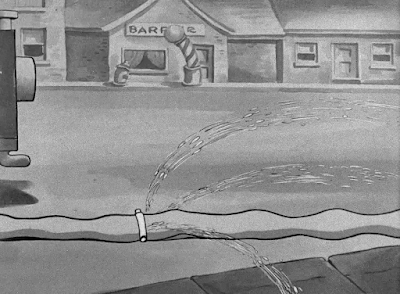A singing Bimbo (accompanied by a ukulele), Ko Ko and Betty Boop rake in profits from their new wonder tonic Jippo.
Where does Jippo come from? We start with a guy bottling it from a barrel. But let’s follow the trail.
The fire hydrant is a classy one. It wipes off its own mouth.
The fact that Jippo is plain, old water doesn’t make sense in light of its effects on people, but that’s just spoiling things. With a Fleischer cartoon of this era (1932), it’s best to get caught up in the absurdities, role reversals, and instant life by inanimate objects that made the studio’s cartoons the most entertaining of the first half of the ‘30s.
Willard Bowsky and Tom Goodson are the credited animators.







"Betty Boop, M. D." has enough sheer weirdness for ten cartoons, but the bit that's always puzzled me comes a little after the fire hydrant gag.
ReplyDeleteA gouty old man in a wheelchair drinks Jippo, then gets up and dances briefly on his bandaged feet. He then lies down in the street and pulls the pavement over himself like a blanket as a gravestone springs up bearing the epitaph "DOOD GRO". The letters transform into a singing face. The old man's arm comes out of his grave and plants a flower, which grows to large size as it vocalises to the music.
"Dood" is the Dutch word for "dead", and I can't believe that its appearance on the gravestone is merely a coincidence. "Gro" doesn't mean anything in Dutch, but it is a common suffix in brand names of fertiliser, e.g., Miracle-Gro. That ties in with the growing/singing flower planted at the end of the scene. Is "Dood Gro" a pun on some Depression-era brand of plant food? What exactly is the joke behind the epitaph?
I wonder if there's anybody anywhere who doesn't prefer the brand of Fleischer weirdness on display here to the studio's later output, when their mantra seems to have become, "How would Walt do it?"
ReplyDeleteSomeone who likes Pudgy over Bimbo? Impossible!
Delete